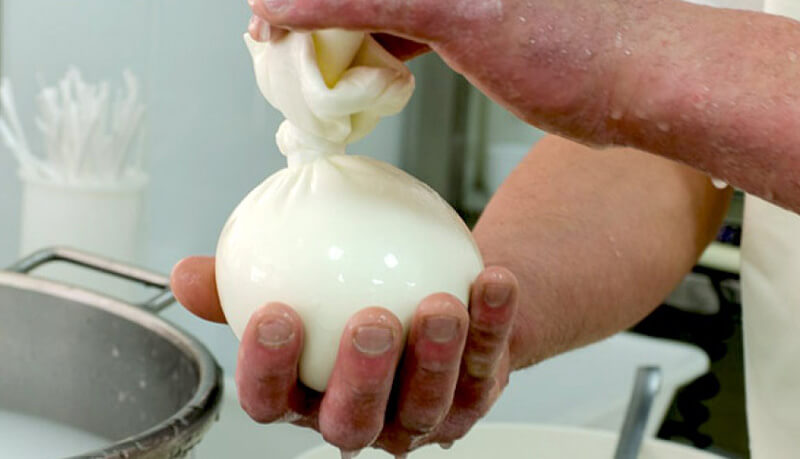How else to introduce Italy’s magnificent Burrata cheese than with a look at the language of the masters who invented it. In Italian burro means butter and that is where you get your first inkling of the buttery richness of this heavenly and creamy cheese which has its origins in the southern part of the country. For those who have tried the real burrata you know that it is far beyond just a cheese, it’s scrumptious artistry – a beautifully handmade bundle of mozzarella with a creamy center that slowly pours out when you slice into it.

This semi-soft cheese is a specialty of the Puglia region located on the heel of the Italian peninsula. It is a pouch of fresh cheese which protects a center of soft creamy pulled curd known as stracciatella – literally coming from the verb to tear. Delicious and supple, it is an Italian specialty that is difficult to resist. It was first produced in the city of Andria in the 1900s by a man named Lorenzo Bianchino who worked at a masseria (a typical stone farmhouse of the region) called Piana Padula making cheese. The type of cheese produced at this masseria was known as manteche a pulled curd cheese filled with butter. As the story goes, the area was hit by an unusually long snowfall in the winter of 1956 causing disruptions and delays to local transportation and affecting the masseria’s ability to send its fresh cheeses throughout the area. Bianchino came up with the idea of creating a protective package of mozzarella to hold the cream and stracciatella which needed to be transported, and in an instant the burrata was introduced to Puglia. Soon word of the sweet milky cheese spread throughout Italy and became a symbol of the region’s already extraordinary culinary traditions.

Burrata is in truth beautiful from the moment you see it – a shiny white bundle of cheese gathered at the top like a perfectly presented gift. It immediately melts in your mouth with its sweet aroma of milk. The cheese was originally made from water buffalo milk but today is most often made with cow’s milk.

It is a fresh cheese made from the combination of milk and whey that was leftover from the previous day. The curds are left to rest in the whey for about five hours, a process which allows for the creation of the stringy mixture which is then worked into the pulled cheese which will form the outer pouch of the burrata. The parcel is then filled with the pulled curd and fresh cream and closed with a ribbon of vegetable fiber. To finish off the process, the burrata is quickly placed in brine for a few minutes.

The end result is a fresh cheese that is rich, milky and subtle all at once. Burrata should be consumed within a few hours of its production and served at room temperature. Delectable on its own it doesn’t require much elaboration for serving. In fact, the ideal way to showcase the Italian masterpiece is to serve it as simply as possible, just like they do in Italy, with only a sprinkle of salt and crack of pepper and a maybe a drizzle of extra virgin olive oil. Burrata also makes an irresistible pairing with a local wine from Puglia which is full-bodied and dry such as Negroamaro. Pure poetry – poesia pura.
Liana Bicchieri